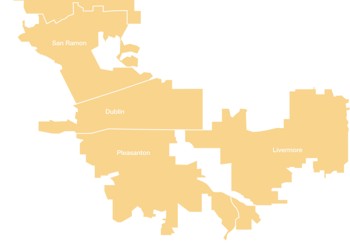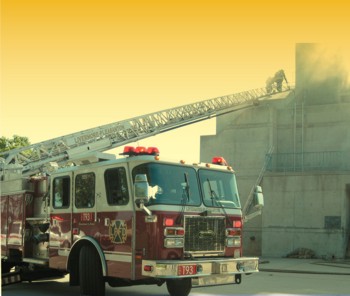Emergency Preparedness Resources Make Business Continuity an Achievable Goal
Emergency Preparedness Resources Make Business Continuity an Achievable Goal


It has been 23 years since the Loma Prieta earthquake hit the Bay Area, but those 15 seconds of shaking will never be forgotten by the people who were here to experience it first hand. Despite those vivid memories, not every local business and resident has taken the steps necessary to be prepared if disaster should strike again.
Fortunately, there are plenty of resources, ranging from programs provided by the Livermore Pleasanton Fire Department and Hacienda Owners Association to a number of online resources, that make it easy to put a recovery plan in place whether your goal is business continuity or simply safety for you and your loved ones.
Among the best resources for Hacienda businesses is the LPFD's Emergency Preparedness unit, managed by Genevieve Pastor-Cohen. The group emphasizes the importance of "the four pillars of preparedness," which includes making a kit, making a plan, getting informed, and getting involved.
The first pillar, making a kit, simply means having supplies on hand. "You can pack it as if you were going on a camping trip - at least a three-day preparedness kit in your vehicle and at least 10 to 14 days of supplies at work and at home," she says. "(It's important to) customize it, because families with babies or elderly members may have specific needs."
The second pillar is making a plan. "How are you going to communicate with your family if you can't physically transport yourself to your house?," says Pastor-Cohen. "What you want is a plan to meet your family if you can't get home, whether it's in your neighborhood or somewhere else that you've designated." At the workplace, a communications plan would include setting up a command structure so that people know whom to contact to either report or receive information. "For example, a point person from each business could be designated to communicate with the first responders, and they should have specific details of what the emergency is. That way, before a first responder goes in, they're aware of what the situation is, whether any casualties are involved, and what kinds of hazards might be present as a result of the disaster."
"Getting informed," the third pillar, speaks to the ability to turn off the electricity, gas, or water in situations where it is necessary. If gas lines in a house rupture because of an earthquake, for example, it is important to shut off the supply line to help prevent fires. "At businesses, of course, the property management company oversees all that, so there are already people in place who can do that."
The final pillar, "getting involved," refers to receiving additional training on what actions to take after a disaster. "At the business place, this means that every company should have training to create an emergency response team," says Pastor-Cohen. "You might have a crisis response team take care of the business continuity aspect and an emergency response team to take care of the people part of it. For example, by establishing an evacuation team, a building coordinator, and floor wardens, companies can make sure everybody gets out safely." The LPFD offers additional training in establishing what are referred to as BERTs - Business Emergency Response Teams - to meet those needs.
While employee safety is the most important goal of any company's disaster preparedness strategy, the ability of the business itself to survive an emergency can be enhanced significantly with proper planning as well. "It's so important for businesses to be proactive so that they can get up and running as quickly as they can after a disaster," says Pastor-Cohen. "After the Northridge earthquake, a number of small businesses closed down and didn't reopen because they couldn't - they didn't have a continuity plan in place. The catastrophic event cost them everything."
Pastor-Cohen recommends the web site of the Disaster Recovery Journal, available online at www.drj.com, as a key provider of information for companies seeking to set up their own business continuity strategies. The quarterly publication, which is available at no charge, was founded in 1987 and provides readers with reliable information on potential dangers, services, industry trends, products, and more. The "Resources" section of the magazine's web site, which Pastor-Cohen says is particularly useful, offers an Executive Guide to Enterprise Business Continuity, free white papers on a variety of relevant subjects, sample disaster recovery and business continuity plans currently used by a variety of institutions, a vendor directory, and even a glossary of terms used by specialists in the field. "Businesses have IT data that they need to be able to mirror, for example, and this site gives you a really good outline regarding how to do that."
She notes that several other web sites provide useful information for disaster preparedness and recovery. Ready.gov, published by the Federal Emergency Management Agency (FEMA), provides Family Emergency Plans, Emergency Supply Lists, and specialized brochures for pet owners, seniors, and people with disabilities as well as business-oriented materials such as Continuity Resource worksheets, Emergency Response Plans, a Business Impact Analysis worksheet, Risk Assessment Tables, and an Insurance Review worksheet. At RedCross.org, the American Red Cross solicits funds and blood donations for disasters that may have already happened, but the organization also offers tips for home, school, and workplace in the site's "Plan & Prepare" section.
"On top of that, a fun tool that just came out a couple years ago is TotallyUnprepared.com, where you can watch cute videos that depict preparedness techniques with a twist of fun," she says. "For example, there's a checklist you can use to survey your house, and then wherever you find a potential problem, you can go to their web site and look at a video to see what you need to do."
Emergency preparedness and response coordination is also an important Hacienda focus. Emergency response coordination in the park is aided by Hacienda Security, which patrols the park 24/7, every day of the year. In the event of a major earthquake, for example, park tenants and owners will be able to receive updated information through the park's security network. Those same users would also be able to post inquiries or provide important information via the park's Security Hotline at (925) 734-6520 or by e-mailing security@hacienda.org.
Hacienda's security network consists of 24 hour contacts for all park tenants and properties which is used to help coordinate a response in the event of an emergency situation. Tenants and facility representatives who want to be a part of this network can contact the Association's office for details at (925) 734-6500 or info@hacienda.org.
If you would like to test out your own preparations, there's a perfect opportunity coming up. An annual statewide earthquake drill, the Great California Shakeout, takes place on October 18 at 10:18 am. So far, over 7.6 million people have registered to take part in this year's event, which provides an opportunity to practice how to protect yourself during an earthquake.
"Basically what participants are doing is exercising some part of their plan, whether it is something like 'drop, cover, and hold' or evacuating a building," says Pastor-Cohen.
To sign up, access www.shakeout.org/california and follow the instructions. The web site also offers companies a number of items that can be used to publicize the event - like fliers in a number of languages - or even recordings with instructions that can be played over a building's intercom system.
While it is not yet scientifically possible to predict exactly when an earthquake or some other disaster will take place, it is simple enough to take the necessary precautions that will make it easier to get through the event with a minimum of disruption to your family and your business. For additional information on local emergency preparedness resources, contact Genevieve Pastor-Cohen, Emergency Preparedness Manager of the Livermore Pleasanton Fire Department, at (925) 454-2317 or gpastor-cohen@lpfire.org.
Also in this issue...
- Interactive Case Management Model Produces Gains for Child Support Services
- Jeepnee Transports People From One Place in Life to the Next
- Business Bits
- Executive Profile: Mary Hanson, Frontier Wealth Strategies
- Homebuilder Taylor Morrison Has a 'Product for Everyone'
- It's Back-to-School Time at New World Music Academy
- Emergency Preparedness Resources Make Business Continuity an Achievable Goal
- Sustainable Agriculture Surrounds Sunol Valley Water Temple
- Good News Bears Spread Cheer and Comfort
- American Cancer Society's Discovery Shop is Favorite Holiday Destination
- Pleasanton Green Scene Fair
- Hacienda Index
- Calendar




